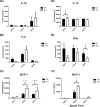Plasminogen deficiency reduces disease severity and immune responses in enterovirus A71-infected mice
- PMID: 40377310
- PMCID: PMC12210968
- DOI: 10.1128/spectrum.03311-24
Plasminogen deficiency reduces disease severity and immune responses in enterovirus A71-infected mice
Abstract
Enterovirus A71 (EV-A71) is a causative agent of hand, foot, and mouth diseases. EV-A71 infections may result in severe neurological complications in children. Although several receptors or attachment molecules for EV-A71 have been identified, EV-A71 can still infect host cells even after blocking these receptors with antibodies. We have previously identified plasminogen (PLG), a circulating zymogen of plasmin, as a cell membrane-associated EV-A71-interacting glycoprotein. We confirmed that anti-PLG antibodies could reduce the binding of EV-A71 to RD cells as anti-SCARB2 and anti-nucleolin. Knockdown of PLG reduced EV-A71 binding to RD cells, and preincubation of PLG with EV-A71 increased virus binding. Enzyme-linked immunosorbent assay and surface plasmon resonance assays demonstrated the direct binding of PLG to EV-A71. We further evaluated the biological characteristics of EV-A71-infected PLG knockout (heterozygous) and wild-type mice. We found that the clinical scores and mortality of WT mice were higher than those of PLG-knockout mice after EV-A71 infection. The viral loads in the spinal cord of PLG knockout mice were lower than those in WT mice 6 days post-infection. EV-A71-associated cytokines such as IL-1β, IL-6, MCP-1, IL-10, and IFN-γ were investigated. Serum IL-10 and MCP-1 expression were significantly higher in EV-71-infected WT mice than in PLG knockout mice, and MCP-1 may be one of the critical chemokines that induce intense inflammation and chemoattracts leukocytes. Our findings reveal a possible role for PLG in EV-A71 infection/pathogenesis and shed light on developing novel therapeutic approaches and drugs to prevent EV-A71 infection.IMPORTANCEUnderstanding the pathogenesis of enterovirus A71 (EV-A71) for developing novel drugs or therapeutic approaches has always been a significant issue. In this study, we demonstrated the interactions between plasminogen (PLG) and EV-A71, characterized the biological effects of EV-A71-infected PLG knockout mice, and evaluated their immune response. We found that EV-A71 caused more severe tissue damage than PLG knockout mice in skeletal muscle, spinal cord, and brain stem. Higher virus protein was observed in these tissues of WT mice. The reduced clinical scores, mortality, and cytokine expression suggested PLG may be involved in EV-A71 infection-induced cytokine storm. The findings and animal model in the current study provide the new drug target for anti-EV-A71 drug discovery.
Keywords: enterovirus A71; plasminogen.
Conflict of interest statement
The authors declare no conflict of interest.
Figures





Similar articles
-
Severe enterovirus A71 pathogenesis and immune responses in human nucleolin transgenic mice.Med Microbiol Immunol. 2025 Jun 16;214(1):30. doi: 10.1007/s00430-025-00842-2. Med Microbiol Immunol. 2025. PMID: 40522392 Free PMC article.
-
The activation of complement C5a-C5aR1 axis in astrocytes facilitates the neuropathogenesis due to EV-A71 infection by upregulating CXCL1.J Virol. 2025 Jan 31;99(1):e0151424. doi: 10.1128/jvi.01514-24. Epub 2024 Dec 16. J Virol. 2025. PMID: 39679722 Free PMC article.
-
Novel virulence determinants in VP1 regulate the assembly of enterovirus-A71.J Virol. 2024 Dec 17;98(12):e0165524. doi: 10.1128/jvi.01655-24. Epub 2024 Nov 13. J Virol. 2024. PMID: 39535185 Free PMC article.
-
Systemic pharmacological treatments for chronic plaque psoriasis: a network meta-analysis.Cochrane Database Syst Rev. 2021 Apr 19;4(4):CD011535. doi: 10.1002/14651858.CD011535.pub4. Cochrane Database Syst Rev. 2021. Update in: Cochrane Database Syst Rev. 2022 May 23;5:CD011535. doi: 10.1002/14651858.CD011535.pub5. PMID: 33871055 Free PMC article. Updated.
-
Seroprevalence of coxsackievirus A6 and enterovirus A71 infection in humans: a systematic review and meta-analysis.Arch Virol. 2023 Jan 7;168(2):37. doi: 10.1007/s00705-022-05642-0. Arch Virol. 2023. PMID: 36609748 Free PMC article.
References
-
- Takimoto S, Waldman EA, Moreira RC, Kok F, Pinheiro F de P, Saes SG, Hatch M, de Souza DF, Carmona R de C, Shout D, de Moraes JC, Costa AM. 1998. Enterovirus 71 infection and acute neurological disease among children in Brazil (1988-1990). Trans R Soc Trop Med Hyg 92:25–28. doi: 10.1016/s0035-9203(98)90939-7 - DOI - PubMed
MeSH terms
Substances
Grants and funding
- 114-2327-B-006-004/National Science and Technology Council
- 113-2327-B-006-003/National Science and Technology Council
- 113-2320-B-006-031/National Science and Technology Council
- 110-2327-B-006-004/NSTC | Institute for Information Industry, Ministry of Science and Technology, Taiwan (III)
- 111-2320-B-006-044/NSTC | Institute for Information Industry, Ministry of Science and Technology, Taiwan (III)
LinkOut - more resources
Full Text Sources
Miscellaneous

